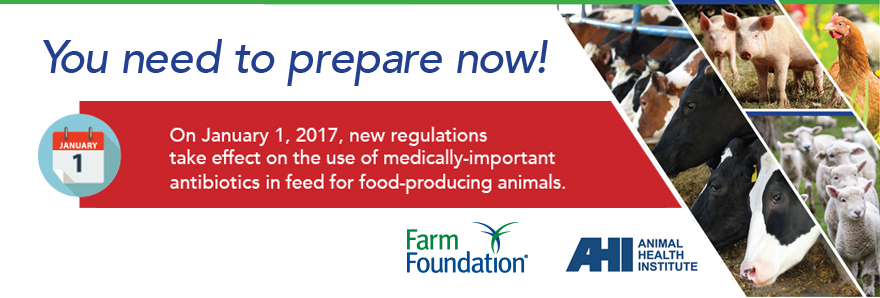| BE PREPARED
On January 1, 2017, livestock producers, feed suppliers and veterinarians will face a new regimen for administering medically-important antibiotics via feed or water to food-producing animals.
Stewardship of antimicrobial drugs in food-producing animals is a complex issue with far-reaching implications for the nation’s consumers, food industry and agricultural sector. New policies of the U.S. Food and Drug Administration—Guidance for Industry #209 and #213—encourage companies to voluntarily change labels of medically-important antibiotics administered in feed or on feed and in drinking water to only therapeutic uses, such as prevention, control and treatment of disease. In addition, under the revised Veterinary Feed Directive (VFD) Rule, use of these drugs will require a veterinarian’s order before a livestock producer, or the owner of any food-producing animal may obtain or feed VFD-medicated feed.
This webpage was compiled by Farm Foundation, NFP and the Animal Health Institute (AHI) as a central resource for producers, veterinarians and feed suppliers to gain more information on the new policies and how those policies will impact management of day-to-day operations.
A local veterinarian or your State Veterinarian can provide additional information. Producers of minor species, such as deer, elk, fish or bees, may want to consult their respective species organizations.
Here are sources where you can learn more about the Veterinary Feed Directive:
Farm Foundation, NFP
A non-advocacy organizations, Farm Foundation, NFP works as a catalyst to convene public and private leaders to examine issues shaping the future of food and agriculture. In the fall of 2015, Farm Foundation hosted 12 workshops across the nation to provide livestock producers, veterinarians and feed suppliers with detailed information on the new FDA policies and VFD rule. Officials from the Center for Veterinary Medicine (CVM) at FDA and the USDA Animal and Plant Health Inspection Service participated in all the sessions. During these workshops, FDA officials received a number of questions about the new policies and VFD rule that they were not able to answer during the session. FDA addressed those questions, and the responses are provided HERE.
Stewardship of Antimicrobial Drug Use in Food-Producing Animals, is a Farm Foundation report of the findings from the 12 workshops. One of the primary findings was the need for additional education work, especially with operators of mid- to small livestock operations.
FOR VETERINARIANS AND EDUCATORS: Farm Foundation and the Animal Health Institute have created an information card to alert livestock producers to the new FDA policies. You can print out as many cards as you need: VERSION 1 prints one card to a page. VERSION 2 prints two cards to a page.
Animal Health Institute
AHI represents the companies that manufacture animal health pharmaceuticals, vaccines and feed additives. Visit the AHI website for details and educational materials on FDA’s Guidance 209 and 213.
In collaboration with the National Pork Producers, National Cattlemen’s Beef Association and the Animal Agriculture Alliance are sponsoring a new educational website to examine how FDA’s new policies will change the way antibiotics are used to keep food animals healthy.
U.S. Food and Drug Administration, Center for Veterinary Medicine
Jan. 3, 2017:
FDA Announces Implementation of #213, Outlines Continuing Efforts to Address Antimicrobial Resistance
http://www.fda.gov/AnimalVeterinary/NewsEvents/CVMUpdates/ucm535154.htm
FDA CVM/S Key Initiatives in antimicrobial stewardship
http://www.fda.gov/AnimalVeterinary/SafetyHealth/AntimicrobialResistance/JudiciousUseofAntimicrobials/ucm535158.htm
List of affected applications: http://www.fda.gov/AnimalVeterinary/SafetyHealth/AntimicrobialResistance/JudiciousUseofAntimicrobials/ucm390429.htm
FDA’s Center for Veterinary Medicine (CVM) has a number of informational resources available on the new policies and VFD Rule. You may also submit questions directly to the Center for Veterinary Medicine at this email address: AskCVM@fda.hhs.gov
Veterinary Feed Directive (VFD) Brochures (with printable versions available)
VFD Producer Requirements
VFD Requirements for Veterinarians
VFD Requirements for Distributors that manufacture VFD Feed
VFD Requirements for Distributors that do not manufacture VFD Feed
VFD Requirements for Veterinarians–For Veterinary Students
FACT SHEET: Veterinary Feed Directive Final Rule and Next Steps
Guidance for Industry #209: The Judicious Use of Medically Important Antimicrobial Drugs in Food Producing Animals
Guidance for Industry #213: New Animal Drugs and New Animal Drug Combination Products Administered in or on Medicated Feed or Drinking Water of Food
Guidance for Industry #120: Small Entity Compliance Guide: Veterinary Feed Directive Regulation Questions and Answers
Provides Q&A on the VFD, with specific topics targeted to veterinarians, feed distributors and producers.
Guidance for Industry #233: Veterinary Feed Directive Common Format Questions and Answers
Provides Q&A on how animal drug sponsors may provide information for VFDs, and the information to be completed by veterinarians.
Veterinary Feed Directive
Blue Bird label site for cattle, updated June 2016.
Blue Bird label site for swine
Blue Bird label site for poultry
Blue Bird label site for other species
VFD Feed Distributors (sorted by state): Feed distributors who have notified CVM/FDA that they will supply VFD feed.
USDA Antimicrobial Resistance Action Plan
RESOURCES FROM SPECIES ORGANIZATIONS
National Cattlemen’s Beef Association Webinar, Oct. 27, 2016: Don’t Get Caught Off Guard: Preparing for Changing Antibiotic Regulations
National Pork Producers Council: Pork Checkoff’s Antibiotics Resource Center
Poultry Health Today
American Sheep Industry Association: Tips on Preparing for the Veterinary Feed Directive
UNIVERSITY EXTENSION SERVICE RESOURCES
Kansas State University, The Beef Cattle Institute
North Dakota State University Extension: Understanding the Veterinary Feed Directive
Food Animal Residue Avoidance Database (FARAD): FARAD is a USDA-funded university-based consortium that is overseen and operated by faculty and staff within the Colleges of Veterinary Medicine at the University of California-Davis, the University of Florida, Kansas State University and North Carolina State University.
RESOURCES FROM VETERINARY ASSOCIATIONS
American Veterinary Medical Association
MEDIA RESOURCES
Feedstuffs’ VFD Central
Bovine Veterinarian: VFD Newsletter
Bovine Veterinarian/Zoetis June 2015 webinar: “Responsible Use of Antibiotics: Understanding the VFD”
Drovers: Practical answers to your VFD questions
AgWeb: Just How Will Veterinary Feed Directive Work? |

